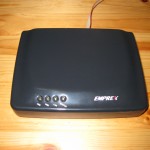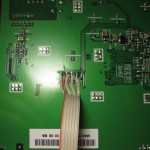I recently got an Emprex NSD-100 from eBuyer, as they were dirt cheap. The purpose of this device is to sit on your network and have a hard disk attached, and sit there just doing BitTorrent downloads all the time, even when your computer is off. Needless to say this is no use to me at all, but it’s a low-power, small box with an ARM processor, 64MB of RAM, USB and Ethernet that other people have hacked to use their own Linux systems on.
Cracking it open
The best way to get Linux on this thing is to get to its bootloader. This is the piece of software that first runs on the device, a bit like the BIOS on your home PC. Its job is to set up the hardware ready for things like a kernel to run, and in our case it can also download a kernel from a TFTP server and run it instead of the built-in version.
To communicate with the bootloader, we need a serial port. Once you open the NSD-100 there is an obvious single unpopulated header, which serves as the serial port. All you need to do is solder on a ribbon cable on the underside of the board, and you get a 3.3V TTL level serial port. By soldering a ribbon cable on the underside of the board, there is no need to remove the EMI shield on the top side of the board.


